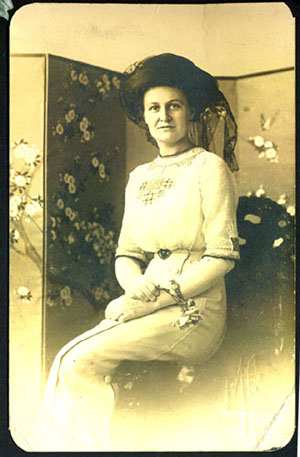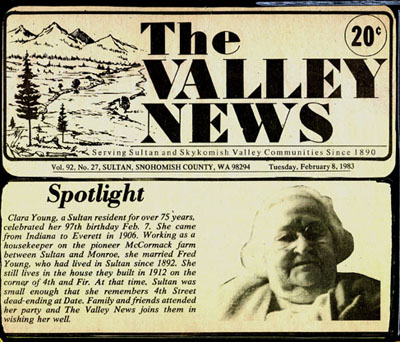
www.snohomishwomenslegacy.org |
|
Clara Morris Young
~ Her Granddaughter Remembers ...1886 - 1983 Clara Morris Young lived what some may say was a common life. But what brought my grandmother west to Washington State and Snohomish County must have been an uncommon sense of adventure. She came to work, socialize and dance, and stayed to marry and raise a family. She adored being called “Mom” and “Grandma” and cooking and keeping house for a husband and two sons. Clara Edith Morris
was born February 7, 1886 outside the town of Mitchell, Indiana. She was the
second of five children born to Robert J. Morris and Sarah Belle Terrell. Her
older sister, Margaret, had married Frederick McCormick, and they were living in
Snohomish County when Clara decided to join them |
 |
Clara arrived at a time when the city was expanding rapidly. Lawrence O’Donnell writes in his book,Everett: Past & Present, that the city population grew from 8,000 in 1900 to 24,814 in 1910. New arrivals came from all over the United States and from overseas. The 1907 Polk directory lists Clara Morris as a “domestic” at 2614 Wetmore Avenue. She would have been twenty-one years old. In 1909 she was living in a boarding house at 2132 Oakes, which meant she had to walk a mile to work as an “ironer” for Independent Laundry at 28th and Cedar because streetcars did not serve that area. In 1910 she got a job as a maid at the Merchant Hotel at 1501 ½ Hewitt Avenue.
In 1910 Clara was invited to attend a “Special Pre-Lenten Dancing party”. Ladies complimentary and “ten minutes devoted to the introduction and instruction on the latest dance ‘The Royal.’ Another invitation to a dancing party at the Eagles Hall in Snohomish advises a “special car leaves Wall and Colby at 8 p.m.” for the Saturday night dance. A note at the bottom directs, “Come prepared to make fun and enjoy fun.” Who could resist?
There is a studio photograph of Clara seated on a stool, wearing a gauzy, shirtwaist blouse with embroidery on the bodice; a slim, straight skirt and a hat. Lifestyle records report 1908 was the year slim dresses without petticoats became popular. Also, no fashionable woman left her house without a hat in the first decade of the 1900s. Clara was evidently a fashion slave.
Clara had the company of her sister-in-law, Sophia Young Jenft, as well as her husband’s sisters-in-law, Hilda Wolters Young, married to William Young; and Olive Humphries Young, married to Daniel Young, Jr., in raising their families in Sultan. Olive Young and Sophia Jenft were widowed early in life and left to raise their sons alone. The four women and their families visited each other’s homes, held dinners, celebrated birthdays and holidays, and mourned their losses together.
Clara’s activities were curtailed when she fell at the age of 60, breaking a hip. Arthritis set in, making walking difficult and keeping her on crutches until her death at age 97. Being a “shut-in,” so to speak, did not hamper her social life, for Clara had her phone and kept the party line busy. It was typical to come into her home and find her chatting away to a neighbor, friend or family member at all hours of the day and night. The Sultan “Home Chats” may have been a regular column for The Valley News, but the ladies of the town kept the real news alive via telephone.
Fred and Clara always attended the annual Pioneer’s Picnic, later called the Old School Mates’ picnic. These were annual gatherings in Sultan in August for anyone who had lived in town or attended school there. People from across the country would return to Sultan, bringing their hampers and picnic baskets of food to share at the high school. Tables were set up on the lawn, and the day was spent visiting and eating. Clara packed a mean hamper of food: cold meat sandwiches, potato salad, and apple pie.
I remember that Clara did not have stomachaches or headaches, and took few if any, medications during her life. She ate sliced onion sandwiches with mayonnaise and used lard in her frying pan. She would ask about the health of her daughter-law’s father, who was ten years younger than Clara, referring to him as “the old man.” She shunned anything associated with being an “old lady.” She did not care for the shawl her son brought her from the Holy Land, and she would not be caught dead in lavender or purple because as far as she was concerned, these were “old ladies’” colors.
| Clara lost Fred in 1963. He died the day after
President Kennedy was assassinated. She outlived her
siblings and nearly all her friends and neighbors, a
fact that troubled her in her last years. Clara
missed her contemporaries, the people with whom she
shared her life and times. However, her independent
spirit, which brought her west as a young woman,
served her to her last days. She lived alone from
1963 until a home care worker moved in to assist her
a year before Clara’s death. Her sons honored her
wish to live in her home and kept in close contact
with phone calls and daily visits. She cooked Sunday
dinners up until her last year of life because it
was her joy to cook for family. Clara’s was an ordinary life lived well to the end. Her mind was clear and she knew everyone down to the great-grandchildren by name. Her legacy was living well every day. |
 |
Personal Experience, Interviews with Clara Morris Young’s
family; Clara Morris Young family records.
© 2005 Roberta Jonnet, All Rights Reserved